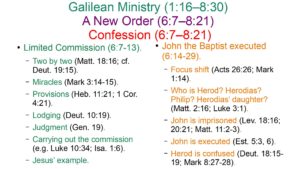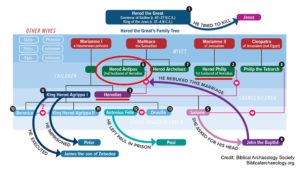The Ministry of Jesus in Galilee
Mark 1:16—8:30
A New King (1:16—3:6).
Kingdom is Near (1:15)
Popularity (1:16-45).
Conflict (2:1—3:6).
Jewish Leaders Reject Him (3:6)
A New Kingdom (3:7—6:6)
Kingdom Has Small Beginnings (4:3)
Continued Conflict (3:7-35).
Parables (4:1-34).
Identity (4:36—6:6).
Jesus’ Town Rejects Him (6:6)
A New Order (6:7—8:21)
Herod & Pharisees (8:15)
Confession (6:7—8:21).
Limited Commission (6:7-13).
There are some differences between this rendition of the Limited Commission and what we see in Matthew’s version (Matt. 10).
They are sent out two-by-two.
He also gave them power to perform miracles—casting out demons, but also healing them of their sicknesses (3:14-15).
They were told to limit the provisions they were to bring with them.
They were to stay in someone’s house while preaching in a particular town.
Shake off the dust under their feet.

This was a typical practice among the Jews after leave a Gentile area.
This was signaling that these who rejected this message should be rejected as Gentiles were at that time.
Jesus then states it would be better on the day of judgment for Sodom and Gomorrah than for that city.
What happened in Sodom and Gomorrah? And what happened to them?
While Sodom was terrible at hospitality to say the least (only Lot, an outsider, showed proper hospitality), at least they weren’t outright rejecting the gospel of Christ. Sodom and Gomorrah didn’t have the miracles that the cities and villages who rejected Jesus and the Twelve had.
Recall one of those cities who rejected Jesus was His own hometown—Nazareth.
The Twelve carry out their commission.
Their goal, much like Jesus’, was to preach repentance.
They also cast out demons and healed the sick.
Why use anointing oil? It was a common remedy at the time for various ailments (e.g. Luke 10:34; Isa. 1:6). It was likely used symbolically—recall that oil was symbolic of the Holy Spirit.
Jesus’ example during His ministry.
It’s likely Jesus Himself was following all of these guidelines (i.e. provisions, lodging), so the disciples knew it could be done. They just needed the push and confidence to know they could do it, too.
Think of all the trials the Twelve would face after Jesus ascended into heaven—they needed to know they could do all these things.
Jesus provided them with this learning environment, almost a safety net, to help prepare them for what they were going to face.
John the Baptist Executed (6:14-29).
We now shift our focus to King Herod and John the Baptist.
It starts with Herod’s reaction to Jesus.
Jesus had become famous, as Paul said to another Herod, “this thing was not done in a corner” (Acts 26:26).
It is then revealed the Herod had executed John, so what we read from vs. 17 to 29 is essentially a flashback.
Recall Jesus did not start His ministry until after John was imprisoned (1:14).
John preaches against Herod and his unlawful wife and is imprisoned (6:17-18) during the 40 days Jesus is fasting in the wilderness.
John is then executed somewhere between 1:14 and 6:13.
Who is Herod? Herodias? Philip? Herodias’ daughter?

He is the son of King Herod the Great who tried to kill Jesus as an infant, successfully killing many other infants (Matt. 2:16).
After Herod the Great died, the kingdom was divided into four provinces, called tetrarchies
This Herod is Herod Antipas tetrarch of Galilee and Perea and son of Herod the Great.
One criticism of Mark is that he calls Herod Antipas a king, when he was never given the honor of that title by Rome.
Whatever the case, this adds to the rustic feel to Mark’s gospel account—likely people called him a king even if he weren’t technically king.
This brother Philip was not the same brother Philip that was Tetrarch in Iturea and Trachonitis (Luke 3:1) – same father for Herod and both Philips, but different mothers for each.
The Philip mentioned here is not known as doing anything great, which frustrated the ambitious Herodias who was married to him.
He was also known as Herod II, and was heir-apparent to Herod the Great for awhile, but was written out of his will at the last moment due to his mother’s involvement in Herod’s death by poison. As a result, he lived in Rome as a private citizen.
Antipas was married, too, and he and Herodias conspired together to divorce their spouses and get married to each other (he was married to a Nabataean princess—they actually fought a battle over this).
Antipas loved Herodias, and Herodias desired power.
In some ways she was much like Jezebel, urging Antipas to gain more power and prestige than he really desired.
So it’s no surprise that she would push him to execute a popular man who preached against her ticket to power.
She did this through her daughter with her first husband Philip. Her name was Salome, and she was an older teenager at this time (born in a.d. 14). This would make her 16 in a.d. 30.
Salome was married to Philip the Tetrarch who died in a.d. 34 at around 59, which would make him 55 in a.d. 30.
It is unclear if she were married by this point in Mark 6 (I couldn’t find a marriage year for them), but I think it is unlikely. She did not have any children with Philip the Tetrarch, so it seems they were not married long before Philip died.

